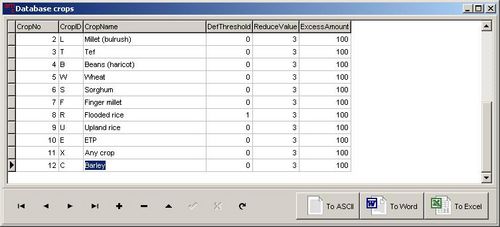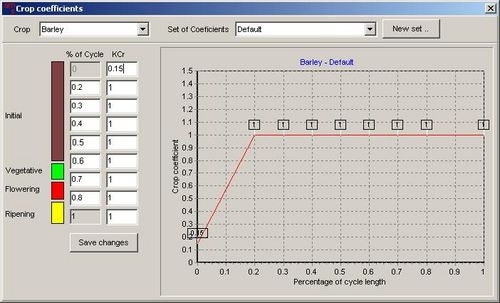[edit]6.1. The FAO Water Balance Model. Monitoring crops.
R. Clark and Peter Hoefsloot [edit]Introduction to the FAO Water Balance Model
[edit]Definition
The FAO Crop Specific Soil Water Balance Model (CSSWB) is a simple and transparent soil water balance model designed to assess the impact of weather conditions on crops. The calculations follow a procedure known since the 1930s as the "accounting" or the "bookkeeping" method of soil water budgeting.
Assume a soil can hold up to WHC mm of available crop water (WHC is soil's Water Holding Capacity). At the end of every (regular) time interval (days, dekads, weeks.. ) it is assumed that the amount of water stored in the soil (Wa) is the sum of the water stored in the soil at the end of the previous period, (Wp), plus rainfall Ra, minus the amount actually evapotranspired by the crop (ETA, or actual crop water consumption) and minus losses ("excess water") through runoff and deep infiltration.
Wa = Wp + Ra - ETA - (Losses) (1)
Whenever Wa drops below 0, it is reset to 0 and whenever Wa exceeds WHC, it is reset to WHC.It is important to notice that the purpose of the calculations is to define the Water Balance Parameters (WBP) which are of relevance for crop yield determination, in particular, the total ETA over the crop cycle. It is also possible to derive total excess water (the sum of Wa-WHC whenever Wa>WHC), the total deficit , or the ETAs at certain critical period of a crop cycle for instance flowering, average soil water content, etc.
One parameter which has been given much weight is the Water Satisfaction Index (WSI), which expresses the percentage of the crop water requirements which has been met.
Good positive correlations are found between WSI and yields (strictly speaking, this is correct only over homogeneous areas where comparable maximum yields are achieved).
For flooded rice, the WSI is calculated differently than for all other crops. Normally, a "deficit" occurs when the soil moisture is depleted. For flooded rice, the deficit starts as soon as soil moisture () drops below capacity.
Some comments about the inputs used in a water balance calculation follow below.
[edit]Rainfall
Equation (1) assumes that all the rainwater, Ra infiltrates instantaneously into the soil, which is an obvious oversimplification. The forecasting errors affecting this term can be improved (reduced) significantly using shorter time intervals (days), and a factor accounting for the amount of water which is actually available for the crops (effective rainfall). The function relating actual rainfall to effective rainfall can be adjusted by trial and error to fine-tune the CSSWB and improve the correlations between actual and estimated yields.
[edit]Actual evapotranspiration (ETA) and phenology
The value of ETA is derived from the water balance calculations. It is equivalent to water requirements (WR) under conditions of sufficient water supply. Values of ETA below requirement are interpreted as water stress.
WR is obtained by multiplying by a crop-specific coefficient (more simply called a 'crop coefficient' or a KCR) by an environmental factor, the Evapotranspiration Potential (ETP) or potential evapotranspiration. The Evapotranspiration Potential (ETP) is a purely climatological concept which expresses the evaporative power of the atmosphere. It is a central notion in agrometeorology.
Early-season values of KCR are mostly low, and KCR increases when growth is most intense, i.e. in the late vegetative stages. In fact, KCR approximates growth rates.
In practice, standard values are used for the crop coefficients (KCR) which depend on the phenology of the crop, a most important input parameter. KCR is obtained empirically from water consumption trials (using lysimeters).
It has been the practice in many countries to use normal ETP instead of actual ETP when conducting the water balance calculations. While it is generally admitted (though rarely proven!.) that ETP varies considerably less than, say, rainfall, the use of normal vs. actual ETP has important implications for the interpretation of water balance parameters.
ETP is a complex parameter, which depends mainly on energy factors (temperature, sunshine), wind and moisture of the air. It is clear that, in particular, temperature and sunshine are usually related, and that ETP is in rather direct relation to the total solar energy available for plant growth.
This means that a water balance calculation conducted using actual ETP better approximates ETA and increases the correlation between the water balance parameters and actual yield.
[edit]Soil water and Water Holding Capacity (WHC)
WHC is usually defined as the difference between field capacity (the water content of a water saturated soil after the excess has been drained off) and the water stored in the soil at the permanent wilting point.
It is another parameter which is derived empirically from field observations or laboratory tests.
The concept itself is retained only for the sake of convenience since soil water suction curves (pF curves) are now widely preferred for other applications. Nevertheless, for straightforward soil water balances, this operational concept remains very useful.
[edit]Monitoring Crops
[edit]Limiting factors for yield
Monitoring crops with a water balance calculation is possible as long as water is a limiting factor for the crop. In circumstances where water is not a limiting factor in any way, water balance output will not be strongly correlated to yields measured. Limiting factors for crop growth can be grouped into four groups:
- Weather dependent, such temperature, solar raddiation, rainfall and CO2 content of the air.
- Crop dependent, such as genetic potential and crop canopy (LAI)
- Related to Pests and diseases (insects, weeds etc..)
- Related to cultivation techniques (irrigation, fertilizer etc..)
Basically, water balance calculations have predictive value for yield in arid and semi-arid areas. In areas where temperatures are high and water is not limited, solar radiation is loosely correlated to yields. In areas of abundant water and high solar radiation during the growing season, temperatures are often more limiting than other factors (Russia, Canada etc..).
[edit]Crops implemented in CM Box
AgroMetShell (part of CM Box) comes with a number of pre-defined crops. These crops have been selected as they are important in terms of crop forecasting for food security. The following crops are implemented:
- Maize
- Millet (bulrush)
- Tef
- Beans (haricot)
- Wheat
- Sorghum
- Finger millet
- Flooded rice
- Upland rice
The crops implemented in AgrometShell can be displayed with the Database-Configure-Crops function.
[edit]Crop coefficients
In the FAO water balance model, the water use of crops is based on weather factors aggregated in the ET0, the water availability through rain, soil and irrigation and the crop coefficients. Crop coefficients describe the relationship between ET0 and water use at every stage of crop growth. Crop coefficients differ from crop to crop and even from crop variety to variety. Therefore more than one set of crop coefficients can be implemented in CM Box.
To view and change crop coefficients, the Database-Configure-Crop Coefficients function is activated. In the window the "default" set of crop coefficients for "Maize" is shown. The curve is independent of cycle length and is fitted through 9 value pairs (See below).
[edit]Defining new crops in AgrometShell
Defining new crops requires two steps. First the crop itself needs to be defined. Then one or more sets of crop coefficients are defined.

| CM Box User Guide | Main Page | About | Special pages | Log in |
Printable version | Disclaimer | Privacy policy |

